|
Harrier T Mk.2/2A/4/4N
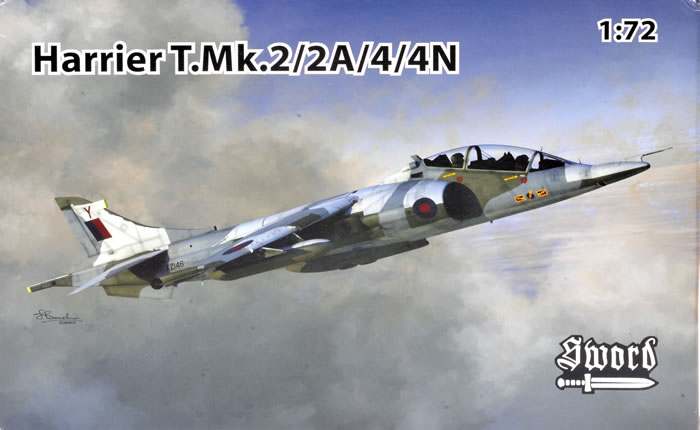
Sword, 1/72 scale
S
u m m a r y |
| Description and Catalogue Number: |
Sword Kit No. SW72098 – Harrier T Mk.2/2A/4/4N |
| Scale: |
1/72 |
| Contents and Media: |
86 grey and six clear styrene parts; one resin part; coloured PE fret of 79 parts; decals for four colour schemes. |
| Price: |
Available online from these stockists:
|
| Review Type: |
FirstLook |
| Advantages: |
These are nicely engineered kits produced to high standards. They have a better quality feel to it than some other limited run brands. The use of coloured PE raises detail levels well beyond routine expectations, and the fret has spare examples of several smaller parts. |
| Disadvantages: |
The closed auxiliary intake doors are disappointing as they droop open when the engine shuts down. |
| Conclusion: |
This kit remains the best Harrier T Mk.2/4 in “The One True Scale”. It is good quality for a limited run kit and provides excellent levels of cockpit detail for the scale.
The one-piece engine nozzles are a slight compromise, but this is an approach shared by some mainstream Harrier kit producers too. To me, they seem okay, but resin alternatives can replace them easily if preferred. Less acceptable are the closed auxiliary doors on the intakes. I accept that it is difficult to mould the drooped doors in plastic, but Sword could have considered using resin for the intakes in this case. However, after market intakes with drooped doors designed for the Esci/Italeri kit should fit Sword‘s kits as well.
Intake gripes aside, this is still a very good kit, and I am sure it will continue to please many Harrier fans. I have also to comment on the price of these kits from most suppliers; they are simply great value in my opinion.
It should come as no surprise that I highly recommend this kit. |
Reviewed by Mark Davies

Airfix's 1/48 scale Spitfire Mk. Vb will be available online from Squadron.com
Background
The general history of the Harrier is well known to many, so I shall just cover the key features of the versions reviewed here. As is the case for many single-seat military aircraft there was a need for a trainer version of the Harrier; this was especially so given its differences to all other types of aircraft. Hawker Siddeley began work on a trainer around the same time it was developing the Harrier GR.1 from the Kestrel. This trainer version was to become the Harrier T Mk.2.
The Harrier trainer’s first flight was in April 1969. It differed from the single-seat version in a number of significant ways. These included a 47-inch longer forward fuselage; a second cockpit raised by 11 inches, a larger ventral fin, a longer ballasted rear tail cone, and the fin moved 33 inches to the rear mounted on an 11-inch tall stub. An 18-inch extension to the fin was introduced during the production run and earlier aircraft had this retrofitted. The T Mk.2 used the Pegasus 101 engine, whereas the Mk.2A used a Pegasus 102, and so it paralleled the engine change made with the Harrier GR.1A.
The GR.3 was the next single-seat Harrier and was powered by the Pegasus 103 engine. It underwent an avionics upgrade during its service, with a laser range finder in the nose and Passive Warning Radar (PWR) in the tailfin. This led to the need for an equivalently equipped two-seat trainer. This was the T Mk.4, although few of them had the same updated avionics fit as the GR.3. The Royal Navy used the T Mk.4 without the laser nose but with the PWR fitted, and were designated T Mk.4N. The fitting of the PWR led to the use of the original GR.1 tailfin, still mounted on the 11-inch high stub, as otherwise there would have been too much side area to the fin.
Whatever the reasons for their shape, I think that the T Mk.2 and Mk.4 Harriers are among the best-looking members of Hawker’s VTOL family. However, I realise there are those who think that they are the ugliest; such can be their polarizing effect. Of course, none of this has any bearing the aircraft’s history, but I for one am glad to have kits of these subjects.
Previous 1/72 scale Harrier T Mk.2 & T Mk.4 Kits
I am aware of a few previous Harrier T Mk.2 & T Mk.4 kits and conversions.
For many years the only injected kit was Heller’s T.Mk4, which is part of their Bobcat range of simplified snap-together kits. This very simple kit is better than it sounds, although it was best used to convert a mainstream single-seat Harrier kit. Heritage Aviation Models released a multi-media resin kit. An article in the July 2005 issue of SAMI advised that this is the same as the earlier Aardvark Resin kit. The article indicated that with quite a lot of effort a reasonable model can be made from this kit. There were also T Mk.2/4 conversions by Airmodel, Pegasus and Veeday Models.
However, all of these kits and conversions were made obsolete by Sword’s release of a new tool kit in two boxings in 2012; one covered the T Mk.2/2A & TAV-8A, and the other the T.Mk 4/4N. The kit reviewed here is the same one, only boxed to combine all four British versions and dropping the USMC’s TAV-8A option (by simply not providing the decals).
The Contents
The kit comes in an end-opening box with digital artwork on the fronts and colour profiles of the decal option on its rear. Sword’s instructions provide a parts map and a generally easy to follow diagrammatic assembly format. All text is exclusively in English. The diagrams are well drawn and better than some long-run brands. The historical account of the aircraft is twice as long as it need be because the same text is repeated in full!
Paint colours. The painting and decal guide has quite adequate four-view colour drawings, one subject per A5 page, and a two-page stencil placement guide. Sword uses generic and military colour names for colour call outs, for both detail painting and the paint and markings guide.
The parts and decals come enclosed in a zip-lock bag, with the clear parts and PE fret further protected in small bags of their own.
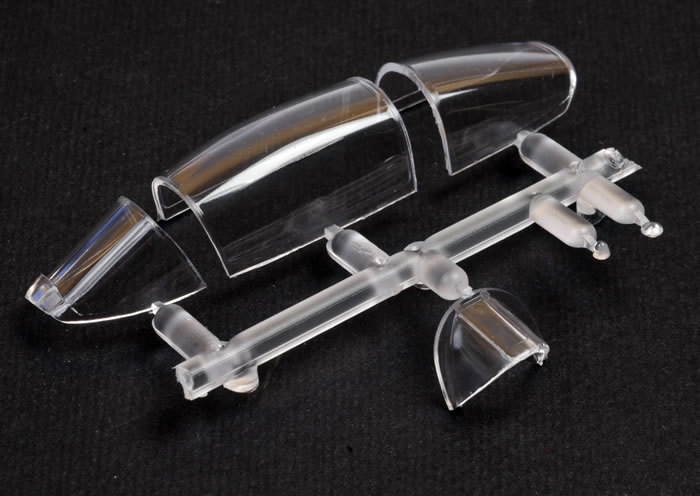
This is a typical Sword kit in that the plastic has a more shiny finish than many other limited run brands. It has nicely moulded parts with quite fine surface detail and acceptably fine sprue gates.
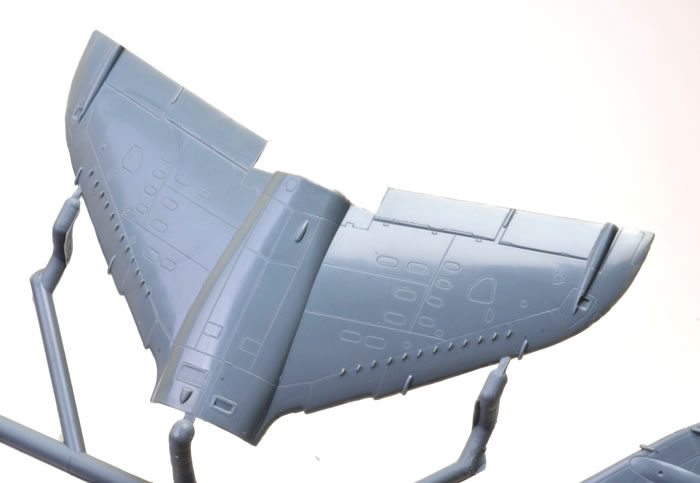
Residual ejector pin towers require removal in some places to enable a good fit, but none are placed so as to spoil moulded detail. Interestingly, there is a lot less flash evident than I found on the same kit I got five years ago; and what very little there is can be easily dealt with. High production standards apply to the resin, clear and coloured PE parts.
The only tool fault I could see that was not evident five years ago affects three of the engine’s compressor fan blades. At first I thought it was tool damage, but on closer inspection the fault is caused by en injection pin almost penetrating the fan moulding from its rear; presumably because the plastic had not cooled enough in this are when the pin forced the parts from the mould. This fault may therefore not apply to all kits. If however it does, the affected area can be hidden behind the rear of the cockpit structure within the air intake mouth.
The Kit
Parts break down is conventional for the type.
Cockpit detail is a combination of plastic and PE parts, with extensive use made of the latter in pre-coloured and plain forms. It is used for the seat details, instrument panels, side consoles, HUDs and rudder pedals.
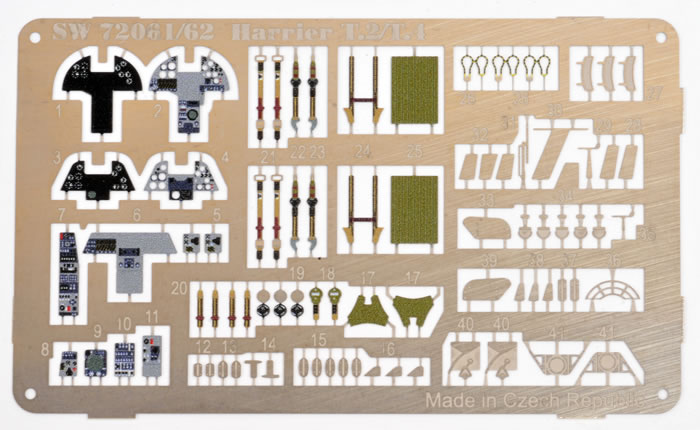
It crossed my mind that some might be tempted to use after market resin seats, but I am inclined to think that the kit seats will look great as they are. The Harrier has very small cockpits, but even so, these should look superb when finished. The three-piece canopy is very fine and clear, and is dressed with PE mirrors and a windscreen wiper. There is also a fourth clear part for the interior rear seat screen. I am sure that some will be tempted to model the canopy open given the level of cockpit detail.
The large front fan of the Pegasus engine is very evident and this mounts to a structure extended up from the nose wheel well. This and the rear main wheel well have quite reasonable detail within. The interior to the airbrake is a resin casting.
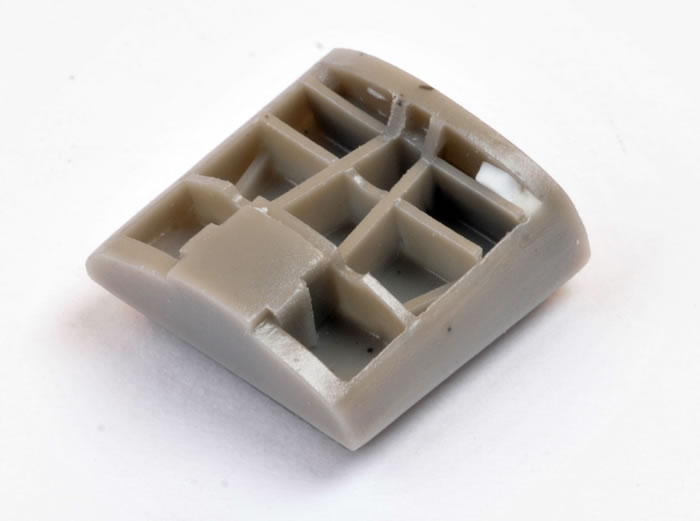
The fuselage halves enclose all of these parts. A nice touch is the way that both sets of the cockpit coaming with their HUDs are separate parts that can be left off until just before the canopy is fitted.
Now to the only real weakness of this kit, and it is one that many Harrier kits share. The auxiliary intake doors are moulded closed rather than drooped open, as they are when the engine is shut down. This is due to the limitations of two-piece injection moulds, but resin intakes would have overcome these should really have been used here I feel. Not all is lost however; there is a strong affinity between the Sword and Esci/Italeri Harrier kits, which means after market intakes with drooped doors designed for the Italian kit should fit.
Some may gripe about the one-piece exhaust nozzles that are also the result of mould limitations. I think that they are okay and preferable to more open two-piece nozzles with awkward seams, as found in some kits. Once again, after-market nozzles for other Harrier kits can easily improve the appearance of the Sword kit.
Staying with the fuselage, there is a choice of cannons or fuselage strakes and as mentioned earlier, noses and tailfins as well. There is a variety of scoops, blade antennae and other details to add. Some are plastic and others PE. All will add an air of scale fineness to the finished model.
The tandem undercarriage units have a quite adequate appearance, as do the main wheels and their doors. Sword has moulded the outriggers in their lowered state, which should suit the majority of modellers.
The wings consist of three parts. The vortex generators are a little thick, but are limited by what is possible with injection moulding, and so they are no different to other Harrier kits in this respect; they should be acceptable to most I feel. Four underwing pylons and two fuel tanks provide the only aircraft stores, but this seems an acceptable payload for a trainer.
I think this should be a simple and enjoyable kit to build, albeit that there are some fiddly small parts to contend with.
Markings
The kit has four decal options:
-
T Mk.2, XW269 / TB, No. 4 Squadron RAF, Gutersloh, Germany, December 1977;
-
T Mk.2A, XW933 / P, No. 20 Squadron RAF, Gutersloh, Germany, June 1974;
-
T Mk.4N, XZ146 / Y, No. 899 Naval Air Squadron, in special markings for the unit’s 50th anniversary, Yeovilton, 1992; and
-
T Mk.4, ZB603 / 718, No 4 Squadron RAF, during AMF exercises in Norway, January 1981.
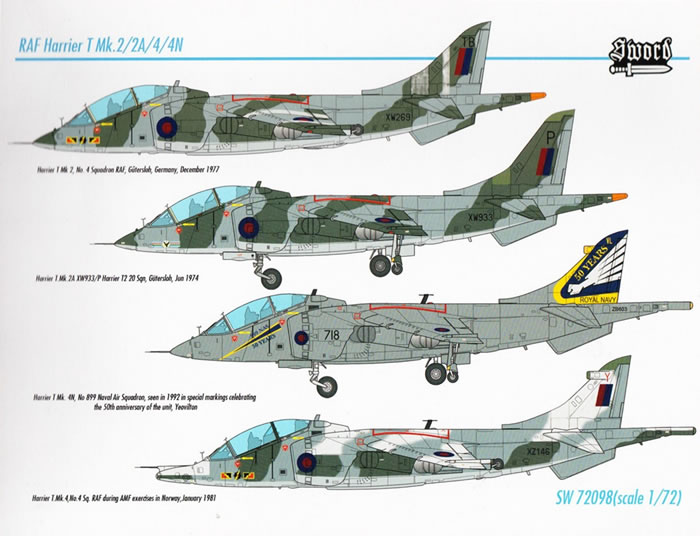
The decals are printed by Techmod and appear to excellent in all respects.
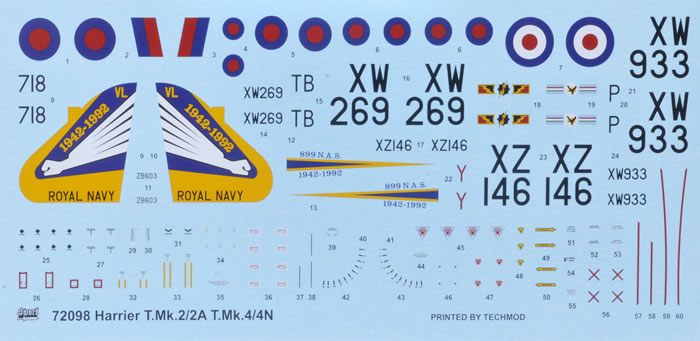
They include an errata sheet for the No. 899 NAS anniversary markings mentioned above.
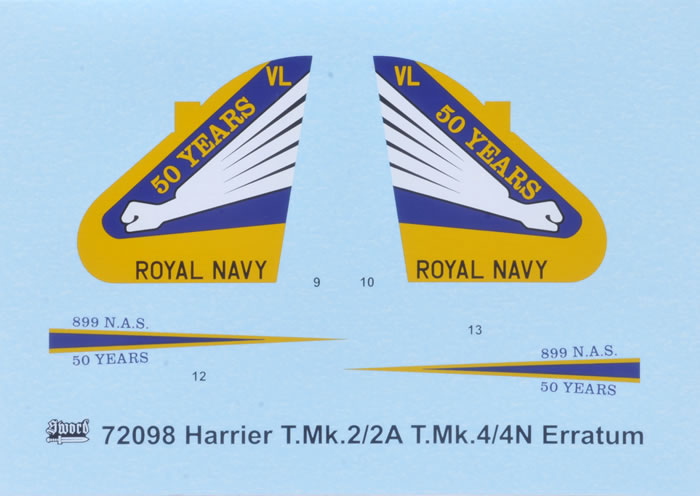
This kit remains the best Harrier T Mk.2/4 in “The One True Scale”. It is good quality for a limited run kit and provides excellent levels of cockpit detail for the scale.
The one-piece engine nozzles are a slight compromise, but this is an approach shared by some mainstream Harrier kit producers too. To me, they seem OK, but resin alternatives can replace them easily if preferred. Less acceptable are the closed auxiliary doors on the intakes. I accept that it is difficult to mould the drooped doors in plastic, but Sword could have considered using resin for the intakes in this case. However, after market intakes with drooped doors designed for the Esci/Italeri kit should fit Sword‘s kits as well.
Intake gripes aside, this is still a very good kit, and I am sure it will continue to please many Harrier fans. I have also to comment on the price of these kits from most suppliers; they are simply great value in my opinion.
It should come as no surprise that I highly recommend this kit.
Thanks to Sword Models for the review samples.
Text and Images Copyright © 2017 by Mark Davies
Page Created 28 March, 2017
Last updated
28 March, 2017
Back to HyperScale Main Page |
